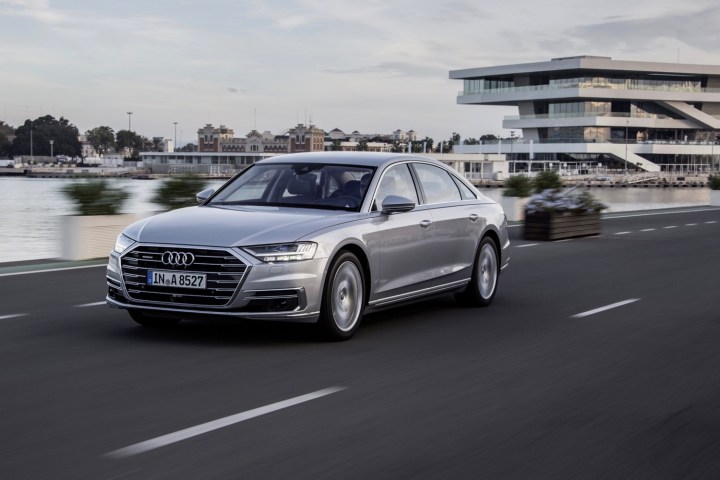
One of the standout features of the redesigned 2019 Audi A8 luxury sedan is Traffic Jam Pilot, a driver-assist system that has been described as a major step toward fully autonomous driving. But Audi won’t offer Traffic Jam Pilot in the United States due to a host of legal, infrastructure, and consumer issues, according to Roadshow.
Traffic Jam Pilot uses a combination of cameras, radar, lidar, and powerful computers to allow the A8 to drive itself in certain situations. The system only works in traffic jams at speeds up to 37 mph on divided highways with clearly marked entrance and exit lanes. But when it’s working, Audi claims Traffic Jam Pilot will allow drivers to take their hands off the wheel and essentially become passengers. We tried it, and it does work.
The system is often described in media reports as the first production SAE Level 3 autonomous-driving system. On the SAE autonomy scale, a Level 0 car has absolutely no autonomous capability or driver aids, while a Level 5 car is fully autonomous, to the point that manual controls are unnecessary. Level 3 cars allow human drivers to take their eyes off the road and their hands off the wheel in certain situations, but still require humans to take over at other times. Audi is concerned that people won’t understand that.
The word “autonomous” is often used to describe assist systems that still require an alert human driver, leading to the potential for major confusion. From drivers jury rigging steering-wheel torque sensors to a series of crashes and near-misses involving cars with driver-assist systems like Tesla’s Autopilot, more education is likely needed for car buyers to understand the true capabilities (and limitations) of these systems.
“Consumer understanding of automated vehicle technologies and driver responsibilities certainly also can be further informed,” and Audi spokesperson told Roadshow. “Because our system is fundamentally different, we won’t be adding to the storylines that have been pretty pervasive lately.”
In addition to lack of consumer education, Audi is concerned about the lack of clear federal regulations for autonomous-driving technology. Without blanket federal standards, Audi believes the existing patchwork of state regulations will make it impossible to sell the same product nationwide.
A third concern is infrastructure. In the U.S., signage, lane markings, and even the configuration of roads themselves can vary widely from state to state, which would make it difficult to ensure that Traffic Jam Pilot would work everywhere. Cadillac, for example, spent years mapping over 130,000 miles of U.S. highway for its Super Cruise system. The system is also geofenced to only function on roads that have been thoroughly mapped.
Changes in any of these factors could lead Audi to bring Traffic Jam Pilot to the U.S. eventually, but don’t expect a Tesla-like software update for existing cars. The system requires specific hardware (including a driver-facing camera, capacitive touch steering wheel, and other items) that won’t be installed on U.S.-market versions of the 2019 A8. However, cars sold in the U.S. will get an adaptive cruise control system with limited steering assist.
Editors' Recommendations
- FAA says 50 U.S. airports won’t get expanded 5G coverage until later in 2022
- 2020 Audi A8 gains plug-in hybrid powertrain, sporty S8 model


